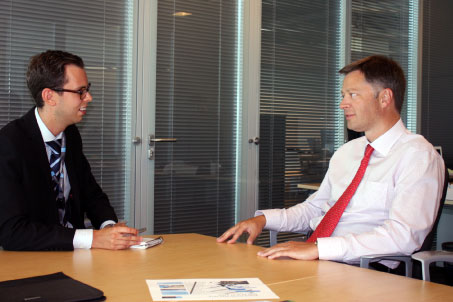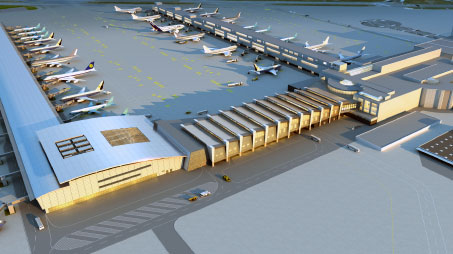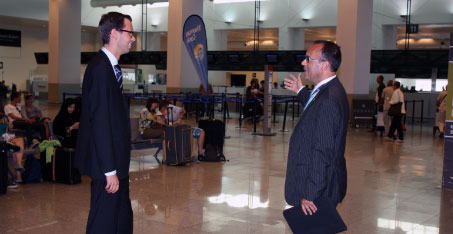
Airport Business’ Andreas Akerman was told by Brussels Airport’s CEO, Arnaud Feist, how the airport’s catchment area has grown with the opening of new rail connections to the airport’s in-terminal train station. Northern Belgium, southern Netherlands and Paris are now reachable with direct train services.
Being the political and diplomatic centre of Europe in a 90-minute catchment area of 19.2 million people certainly helps, but the current network composition is also a key attraction, explained Léon Verhallen, Brussels Airport’s Head of Aviation Marketing. Brussels Airlines has a strong network in Western Europe – Scandinavia, the UK, France and the Iberian Peninsula – as well as a unique long-haul network serving 19 destinations in Africa. For example, one of the factors that convinced Thai Airways to start serving Brussels is the strong onward network to French regional airports, which otherwise is a market dominated by Air France and SkyTeam, said Verhallen.
Brussels Airport is subject to intense competition for long-haul growth, with the close proximity of Amsterdam Schiphol, Paris-CDG and Düsseldorf airports, while low-fare competition within its catchment area comes from airports such as Charleroi, Cologne/Bonn and Eindhoven. In October, Brussels Airport was recognised for its route development strategy at the World Routes Marketing Awards held in Abu Dhabi. It was not only recognised as the best airport in Europe, but also won the overall World Routes Airport Marketing Award. This is particularly significant as the awards are voted for by the airlines themselves, and is tangible recognition of the airport’s success in securing new airlines, new routes and increased frequencies.
Airport Factbox
Passengers (2011): 18.8 million (+9.3%)
Number of airlines: 90 (5 added in 2012)
Number of destinations: 228 (8 added in 2012)
Full-service/LCC split: 85/15
Business demand makes Thai Airways grow
Thai Airways is only one of two Star Alliance airlines to have started serving Brussels since the airport became an alliance hub. The airline’s Bangkok service, which launched in November last year, has proved to be a considerable success with particularly impressive load factors in business class. A year after the route launched, aircraft capacity has already increased as the airline switched from 292-seat 777-200ER to 312-seat 777-300ER with more seats in both the economy and premium cabins, and in February, the airline will also add an additional, fourth weekly frequency on the route.
The other new Star Alliance arrival is Air Canada, which began operating daily flights from Montréal to Brussels in June 2010. This means that all North American members of the alliance now serve Brussels, but the airport also attracts other long-haul services. Most notable is Jet Airways, which operates a scissor-hub at Brussels for its flights between India and North America.

Construction of Brussels Airport’s new Connector building will begin early next year. Once completed, it will let passengers transfer over ground between the airport’s two piers, lowering connecting times and enhancing the passenger experience. The airport is already experiencing growing transfer traffic, not least as long-haul traffic is on the rise and expected to grow further.
Infrastructure preparations for further growth
In order to accommodate further expansion, Brussels Airport is set to embark on a very big investment plan over the next few years. Arnaud Feist, Brussels Airport’s CEO, explained to Airport Business that the first major construction project is the Connector building that will connect non-Schengen Pier B with Pier A, which is mostly home to intra-Schengen traffic. The building will replace the current underground tunnel that is used by 10 million passengers a year.
The benefits with the new building are many. The larger, centralised security checkpoint will reduce queues and, because it serves both piers, speed-up connecting times. The fact that passengers will no longer lose time going up and down to the tunnel, but remain on the same level will also speed up transferring times between the two piers. Another important aspect is the enhanced passenger experience, as the walk through a tunnel without daylight will be replaced with a bright and airy building over ground with shopping and dining facilities. Construction is set to start early 2013 with completion scheduled for early 2015.
With forecasted growth particularly in the long-haul segment, Brussels Airport is also increasing the number of widebody stands to facilitate more long-haul arrivals. Two stands were recently added and a further two will be added next year. The next major construction project at the airport is an extension of the current Pier A, which will add further contact gates and reduce the need for aircraft to park at remote stands.
Ten years ago, a baggage system was ordered for installation under Pier A in order to speed-up baggage handling and to facilitate connections within the same pier, removing the need for bags to be transported via the central baggage area. Although the system was constructed with Sabena in mind, transfer traffic has now again reached the levels when introduction of the system makes sense, and the €40 million investment has now been finalised and is in use as of this past summer.
Brussels Airport was also one of the first to adopt Airport Collaborative Decision-Making (A-CDM), which aims to improve the overall efficiency of airport operations through collaboration between all stakeholders. It has seen tangible benefits, with A-CDM contributing to reducing aircraft taxiing times by two minutes.

Brussels Airport’s existing airline customers’ networks help attracting new airlines, according to Léon Verhallen, Head of Aviation Marketing. In particular, Brussels Airlines has a strong network in Western Europe, as well as a unique long-haul network to Africa that is attractive to both fellow Star Alliance airlines and unaligned carriers.
Multimodality through improved rail access
Brussels Airport, which pioneered rail access with the opening of an in-terminal train station in 1958, has just taken a next major step in improving access to the airport. With the opening last June of a connection between the main rail line to the north of the airport and the airport train station, new direct access opportunities have opened up as the airport train station has become a through-station able to accommodate high-speed trains. “For short distances, trains are the future,” Feist said and pointed out politicians’ discussions about banning short flights.
With the new opportunities brought by this, Brussels Airport is expanding its catchment area by working together with train operators to improve direct connections with the airport train station. Antwerp in northern Belgium is now reachable from the airport in 25 minutes and southern parts of the Netherlands can now access Brussels Airport faster than Amsterdam Airport Schiphol, said Feist. Brussels Airport already attracts significant passenger numbers from neighbouring countries and departing Dutch passengers total 600,000 annually; however, this is a number that Brussels Airport wishes to grow.
The airport is also developing high-speed access to Paris together with Thalys, which already operates to the airport with limited frequencies. The intention is for staff from Brussels Airport to be onboard in the future, providing information, offering check-in onboard the train and helping with baggage. There are hopes for future train services to Germany too, giving Brussels further reason to call itself the ‘Capital of Europe’.







